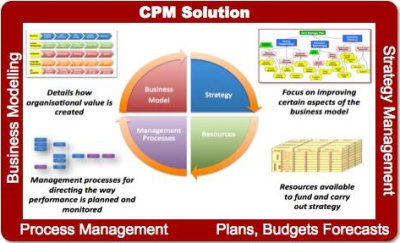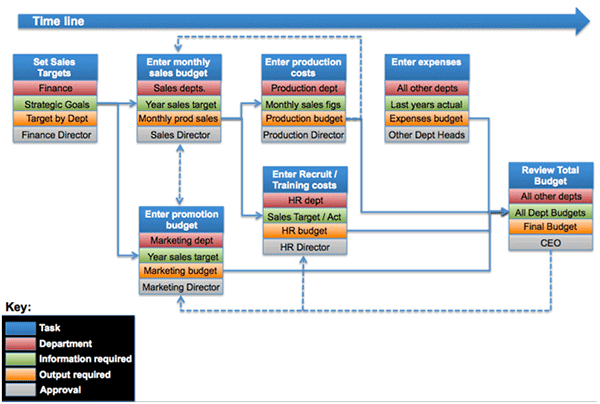1. Workflow Overview 
Workflow is critical to a CPM application in the same way that it is critical to ERP. It is through workflow that users are directed and their attention focused onto their roles and responsibilities through the different performance management processes.
The activities involved tend to be classified into the management processes. To construct the right CPM processes, which together should focus on achieving the organisation’s mission, the following needs to be determined for each:
- Process purpose: What is the purpose of each process and what decisions need to be supported?
- Process activity: Who is involved in those decisions and what information do they require? What input is expected from them based on the decision taken/to be taken? How is the decision validated / approved?
- Process timing: In what timescales should those activities be run and how are they triggered? What happens if an exception is detected that jeopardises the success of the plan outside of the normal planning process?
2. Process Purpose and the Decisions to be Supported
Each organisation needs to define the purpose of individual processes for themselves. Below are examples that are typically common for most organisations.
Strategic Planning:
To produce a long-term plan that identifies goals to be achieved within set resource constraints for a defined business environment. The decisions to be supported include:
- What are the overall goals to be achieved in the next 3-5 years?
- What are the resource constraints in which the organisation should operate in each of those years?
- What assumptions should be made about the business environment over that period?
- What are the broad strategies to be implemented (i.e. the way in which the organisation is to achieve the goals)?
- How is the success of each strategy to be measured?
Tactical Planning: To agree a set of improvement initiatives and associated costs for each strategy that ensures the organisation achieves its goals within the defined constraints. The decisions to be supported include:
- What initiatives are required to implement each strategy? How much would each of these cost, who would be responsible and what measures best indicate that they are being implemented?
- Which combinations of initiatives give the best use of resources within the defined constraints?
- Which initiatives are to be approved that will then become the focus of the financial plan?
Financial Planning/Budgeting: To create a financial plan that represents how resources are to be allocated to both the main business model and the strategy model; and the financial results that are to be expected. It should also include how the plan and any capital expense will be funded. The decisions to be supported include:
- What resources should be assigned to the CPM Business model for areas not covered by strategic initiatives?
- What resources need to be assigned to the strategic initiatives (this may have been decided in the tactical planning process)?
- How does the total financial position compare to the strategic plan?
- Is the financial plan realistic and - how does this compare to last year and the current forecast?
- How will the plan be funded – from which sources and at what time?
Forecasting: Unlike budgeting which seeks to determine what the future should be like, forecasting tries to predict the most likely results that may be achieved based on current understanding of the market and current/planned activities. The decisions to be supported include:
- What size will the market be in the short and mid-term future?
- What future revenues/income can we expect in the short and mid-term future? What is the status of that income (e.g. what % of certainty can be applied?
- What resources will be required to support that predicted future?
- What will be the likely values of KPIs connected with strategy and overall objectives?
Management Reporting: To allow management to review current and forecast results in order to make adjustments to Improve performance. The decisions to be supported include:
- Are we on track to achieve our objectives?
- Is the financial position of the organisation as planned?
- Are the strategic initiatives being implemented, and to what extent?
- How well are the strategic initiatives performing?
- Were the assumptions made about the business accurate?
- Are the costs of the initiatives supporting each strategy worthwhile?
- What things are most likely to deviate from plan, and what would be the impact on finances and long-term goals?
- How well does the forecast predict actual performance?
- Are there sufficient resources for each initiative?
- What, if anything, needs to change to achieve future success?
Risk Management:
To assess risks and their impact on the current plan and to develop contingency plans that avoid or negate those risks. The decisions to be supported include:
- Where are the risks in the current plan?
- How likely are those risks to materialise?
- What warning signs can be put in place to highlight their status?
- What can be done to avoid them?
- What should be done if they occur?
3. Process Activity
As mentioned earlier, this part of the implementation details:
- The people involved in each of the decisions to be supported
- The information they require to support those decisions
- What output is expected from them based on the decision taken/to be taken
- How decisions are to be validated / approved
From the questions shown above in section 4.2, the information required and the people involved can be worked out. Much of the information given to users will come from the output of other users and so the best way to show this relationship is through an activity map of the different tasks involved, their dependencies, and the departments responsible.
The following example shows how this can be applied to one part of the budgeting process, which has been designed to support the decision: “What resources should be assigned to the CPM Business model not covered by strategic initiatives”.

In the above schematic, the time line and order of the activities are shown:
- Task – a description of the piece of work to be carried out as part of the process
- Department – the people/departments involved in carrying out the task
- Information required – what information they require that would help them in completing the task in accordance with the overall objectives
- Output required – the information the department/user should provide as a result of completing the task
- Approval – the person who should approve that the task has been completed successfully
In the above example, the items are not in detail – what is provided to give an idea of what needs to be defined. For example some of the information should relate to market conditions, and sales will probably be split into product groups or services. Similarly, there will be more feedback loops that are not shown, and all budgets will need to be combined to give a total budget situation.
As mentioned this schematic is for one part of the budget process. All parts will need to be defined and linked to show dependencies and the order in which they are to occur. This provides the specification for the workflow software.
4. Data Entry screen and reports
For each activity shown in the activity map, the ‘slice’ of data that each user will need to make their decisions, and the slice of data they will need to complete as part of their response, will need to be defined. If the data can’t be defined from the business model, then that model will need to be amended.
Similarly, when presenting or gathering information, numbers don’t tell the whole story. There will need to be provision for handling text that forms the basis of a two-way communication.
The format and layout of these screens should provide the information in the context of the decision to be made. This will require data to be presented from all parts of the CPM model as well as summary analyses that may come from supporting BI models.
5. Process Timing
Most organisations have an internal management calendar that is used to trigger the different processes outlined for planning and monitoring performance. Therefore for each activity, defined in Section 4.3 there needs to be a timescale in which the user must respond. This will include when the activity can start (which itself may be dependent on the completion of another activity) and when it is to be completed.
But what happens if something doesn’t go to plan? What if the assumptions on the business environment are not right? Or if forecast expenses are going to be greatly over budget? What if a particular initiative is not achieving the right effect?
There’s no point in waiting for the next planning round, which could be in a years’ time, in dealing with these issues. Research into high-performing companies found that: “Best Practice companies decouple their internal management processes from the calendar and provide a set of planning and reporting processes that utilize continuous processing and monitoring of activity. The passage of time becomes (just) one of many criteria for triggering the reporting of information or the initiation of planning or forecast activities.”1
The report goes on to say: “Aspects of strategic planning are not once-a-year events but a continuous process. The pace of change is so great that management needs to monitor the strategic implications of new developments on a continuous basis”.2
To manage performance, organisation’s must take action as soon as potential issues arise. And that means triggering some or all of those activities defined in the activity map, but in the context of putting the plan back on track
To do this a list of possible ‘exceptions’ should be defined along with the activities to be triggered should those exceptions materialise. This should include:
- What exception should be detected? E.g. Forecast sales at the end of the year being under budget by more than 10%
- What activity not yet defined should be triggered? E.g. request sales departments supply more information on situation
- What existing activity should be triggered and for which departments?
- How long do they have to complete the activity?
- Who approves the output?
- Who or what decides that the task is complete?
- What task should be run after this?
2 Best Practices in Planning and Performance Management, David Axson
Subscribe to
FP&A Trends Digest

We will regularly update you on the latest trends and developments in FP&A. Take the opportunity to have articles written by finance thought leaders delivered directly to your inbox; watch compelling webinars; connect with like-minded professionals; and become a part of our global community.

